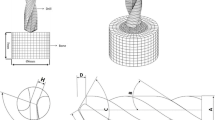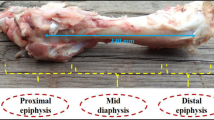Abstract
Drilling of bone is a common surgical procedure in orthopedics to produce holes for screw insertion. The force and temperature rise in bone drilling are two important factors affecting the outcome of the process. The present work attempts to investigate the effect of drill point angle on the level of force and temperature in bone in the presence of ultrasonic vibrations imposed on the drill along the drilling direction. The effect of drill speed on the drilling force and bone temperature was studied using two types of drills with different point angles. The influence of a range of ultrasonic frequencies and amplitudes of vibrations on drilling force, torque and surface temperature of bone was also investigated. The drilling force and bone temperature were found to be strongly influenced by the drill point angle in the presence of ultrasonic vibrations. The drill with larger point angle caused more force and temperature compared to the drill with smaller point angle. Ultrasonic frequency above 15 kHz was observed to produce more temperature in bone for both types of drill geometries. This study found drill with smaller point angle favorable for safe and efficient drilling in bone.













Similar content being viewed by others
References
Eriksson, A. R., Albrektsson, T., & Albrektsson, B. (1984). Heat caused by drilling cortical bone: Temperature measured in vivo in patients and animals. Acta Orthopaedica Scandinavica, 55(6), 629–631.
Field, J. R., & Sumner-Smith, G. (2002). Bone blood flow response to surgical trauma. Injury, 33(5), 447–451.
Berman, T., Reid, J. S., Yanicko, D. R., Sih, G. C., & Zimmerman, M. R. (1984). Thermally induced bone necrosis in rabbits: relation to implant failure in humans. Clinical Orthopaedics, 186, 284–292.
Eriksson, A. R., & Albrektsson, T. (1983). Temperature threshold levels for heat-induced bone tissue injury: A vital microscopic study in the rabbit. Journal of Prosthetic Dentistry, 50(1), 101–107.
Alam, K. (2014). Experimental and numerical investigation of cracking behavior of cortical bone in cutting. Technology and Health Care, 22(5), 741–750.
Jantunen, E. (2002). A summary of methods applied to tool condition monitoring in drilling. International Journal of Machine Tools and Manufacture, 42(9), 997–1010.
Alam, K., Khan, M., & Silberschmidt, V. V. (2014). 3D finite-element modelling of drilling cortical bone: Temperature analysis. Journal of Medical and Biological Engineering, 34(6), 618–623.
Albertini, M., Herrero-Climent, M., Lazaro, P., Rios, J., & Gil, F. (2012). Comparative study on AISI 440 and AISI 420B stainless steel for dental drill performance. Materials Letters, 79, 163–165.
Karmani, S., & Lam, F. (2004). The design and function of surgical drills and K wires. Current Orthopaedics, 18(6), 484–490.
Natali, C., Ingle, P., & Dowell, J. (1996). Orthopaedic bone drills–can they be improved? Temperature changes near the drilling face. Journal of Bone and Joint Surgery. British Volume, 78(3), 357–362.
Alam, K., Hassn, E., & Bahdour, E. I. (2015). Experimental measurements of temperatures in ultrasonically assisted drilling of cortical bone. Biotechnology and Biotechnological Equipment, 29(4), 753–757.
Bachus, K. N., Rondina, M. T., & Hutchinson, D. T. (2000). The effects of drilling force on cortical temperatures and their duration: An in vitro study. Medical Engineering & Physics, 22(10), 685–691.
Abouzgia, M. B., & Symington, J. (1996). Effect of drill speed on bone temperature. International Journal of Oral and Maxillofacial Surgery, 25(5), 394–399.
Saha, S., Pal, S., & Albright, J. (1982). Surgical drilling: Design and performance of an improved drill. Journal of Biomechanical Engineering, 104(3), 245–252.
Alam, K. (2015). Directional dependent analysis of force and torque in conventional and ultrasonically-assisted drilling of cortical bone. Scientia Iranica Transactions B: Mechanical Engineering, 22(1), 258–263.
Tu, Y. K., Chen, L. W., Ciou, J. S., Hsiao, C. K., & Chen, Y. C. (2013). Finite element simulations of bone temperature rise during bone drilling based on a bone analog. Journal Medical and Biological Engineering, 33(3), 269–274.
Pandey, R., & Panda, K. S. (2013). Drilling of bone: A comprehensive review. Journal of Clinical Orthopaedics and Trauma, 4(1), 15–30.
Augustin, G., Zigman, T., Davila, S., Udilljak, T., Staroveski, T., Brezak, D., et al. (2012). Cortical bone drilling and thermal osteonecrosis. Clinical Biomechanics, 27(4), 313–325.
Hillery, H. T., & Shuaib, I. (1999). Temperature effects in drilling of human and bovine bone. Journal of Materials Processing Technology, 92, 302–308.
Augustin, G., Davila, S., Mihoci, K., Udiljak, T., Vedrina, D. S., & Antabak, A. (2008). Thermal osteonecrosis and bone drilling parameters revisited. Archives of Orthopaedic and Trauma Surgery, 128(1), 71–77.
Heisel, U., & Pfeifroth, T. (2012). Influence of point angle on drill hole quality and machining forces when drilling CFRP. Procedia CIRP, 1, 471–476.
Feito, N., Díaz-Álvarez, J., Díaz-Álvarez, A., Cantero, J. L., & Miguélez, M. H. (2014). Experimental analysis of the influence of drill point angle and wear on the drilling of woven CFRPs. Materials, 7(6), 4258–4271.
Alam, K., & Silberschmidt, V. V. (2014). Analysis of temperature in conventional and ultrasonically-assisted drilling of cortical bone with infrared thermography. Technology and Health Care: Official Journal of the European Society for Engineering and Medicine, 22(2), 243–252.
Wang, Y., Cao, M., Zhao, Y., Zhou, G., Liu, W., & Li, D. (2013). Experimental investigations on microcracks in vibrational and conventional drilling of cortical bone. Journal of Nanomaterials, Article ID 845205.
Alam, K., Mitrofanov, A. V., Bäker, M., & Silberschmidt, V. V. (2009). Measurements of surface roughness in conventional and ultrasonically-assisted bone drilling. American Journal of Biomedical Sciences, 1(4), 312–320.
Alam, K., Khan, M., & Silberschmidt, V. V. (2013). Analysis of forces in conventional and ultrasonically assisted plane cutting of cortical bone. Proceedings of the Institution of Mechanical Engineers. Part H, Journal of Engineering in Medicine, 227(6), 636–642.
Augustin, G., Davila, S., Udiljak, T., Vedrina, D. S., & Bagatin, D. (2009). Determination of spatial distribution of increase in bone temperature during drilling by infrared thermography: Preliminary report. Archives of Orthopaedic and Trauma Surgery, 129(5), 703–709.
Feldmann, A., & Zysset, P. (2016). Experimental determination of the emissivity of bone. Medical Engineering & Physics, 38(10), 1136–1138.
Alam, K. (2015). Experimental measurements of temperatures in drilling cortical bone using thermocouples. Scientia Iranica Transactions B: Mechanical Engineering, 22(2), 487–492.
Makhdum, F., Phadnis, V. A., Roy, A., & Silberschmidt, V. V. (2014). Effect of ultrasonically-assisted drilling on carbon-fibre-reinforced plastics. Journal of Sound and Vibration, 333(23), 5939–5952.
Cotter, D. J., Woodworth, G., Gupta, S. V., Manandhar, P., & Schwartz, T. H. (2015). Infrared thermal imaging during ultrasonic aspiration of bone. Physics Procedia, 63, 167–176.
Author information
Authors and Affiliations
Corresponding author
Rights and permissions
About this article
Cite this article
Alam, K., Ghodsi, M., Al-Shabibi, A. et al. Experimental Study on the Effect of Point Angle on Force and Temperature in Ultrasonically Assisted Bone Drilling. J. Med. Biol. Eng. 38, 236–243 (2018). https://doi.org/10.1007/s40846-017-0291-8
Received:
Accepted:
Published:
Issue Date:
DOI: https://doi.org/10.1007/s40846-017-0291-8




